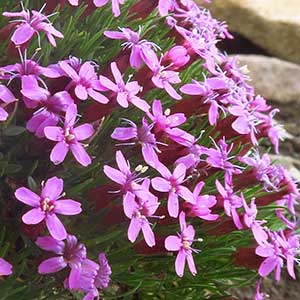Silene acaulis
Silene dioica
moss campion, silène acaule
red campion, red catchfly, silène dioïque
ascending, decumbent at base, branched, shortly rhizomatous, to 80 cm, softly pubescent, ± glandular, at least distally, rarely subglabrous.
erect, leafy proximally, 3–6(–15) cm, old leaves persistent at base.
mostly basal, densely crowded and imbricate, sessile;
blade 1(–3)-veined, linear-subulate to lanceolate, 0.4–1(–1.5) cm × 0.8–1.5(–2) mm, margins cartilaginous, often ciliolate especially proximally, apex acute, glabrous to scabrous.
sessile at mid and distal stem, petiolate to spatulate proximally;
petiole equaling or longer than blade of basal leaves;
blade ovate to elliptic, 3–13 cm × 10–50 mm (not including petiole), apex acute to acuminate, sparingly pubescent, densely so on abaxial midrib.
solitary flowers.
dichasial cymes, several- to many-flowered, open, bracteate;
bracts lanceolate, 4–20 × 2–7 mm, herbaceous, softly hairy throughout with long-septate hairs, not glandular, or with some glandular hairs.
2–40 mm.
ascending, 0.2–3 cm, usually shorter than calyx.
bisexual or unisexual, all plants having both staminate and pistillate flowers, others having only pistillate flowers, subsessile or borne singly on peduncle;
calyx 10-veined, lateral veins absent, tubular to campanulate, (5–)7–10 mm, herbaceous, margins often purple tinged, dentate, sometimes ciliate, ± scarious, glabrous, lobes lanceolate to ovate, 1–2 mm;
petals bright pink, rarely white, limb unlobed to shallowly 2-fid, 2.5–3.5 mm, base tapered into claw, auricles and appendages poorly developed;
stamens exserted in staminate flowers, not so or aborted in pistillate flowers;
styles 3.
unisexual, some plants having only staminate flowers, others having only pistillate flowers, 20–25 mm diam.;
calyx 8–12-veined, campanulate, narrowly so in staminate flowers, broadly in pistillate, 10–15 × to 7 mm in flower, 11 mm broad in fruit, herbaceous, margins dentate, softly pubescent, lobes 5, erect, lanceolate, 2–3 mm;
petals bright pink, clawed, claw equaling or longer than calyx, limb spreading horizontally, broadly obovate, unlobed or 2-lobed, to 12 × 12 mm, appendages 4, ca. 1 mm;
stamens and stigmas equaling petal claw;
styles 5.
3-locular, cylindric, equaling or to 2 times calyx, opening by 6 recurved teeth;
carpophore ca. 1 mm.
broadly ovoid to globose, equaling and often splitting calyx, opening by 5 (splitting into 10) revolute teeth;
carpophore absent.
light brown, reniform, 0.8–1(–1.2) mm broad, dull, shallowly rugose.
dark brown to black, broadly reniform, plump, 1–1.6 mm, densely and evenly papillate.
= 24.
= 24.
Silene acaulis
Silene dioica
Silene acaulis is a variable species, and most workers have recognized infraspecific taxa in North America: subsp. acaulis (subsp. exscapa and subsp. arctica), which is predominantly arctic; and subsp. subacaulescens, which extends down the Rocky Mountains from Alaska to Arizona and New Mexico. In subsp. acaulis, the leaves are flat and short and the flowers are subsessile and smaller in size. Subspecies subacaulescens is typically a larger, less-compact plant with longer, narrower leaves and larger, pedunculate flowers. However, in many populations, these two variants are poorly differentiated, and in others both occur together, connected by intermediates.
Silene acaulis is widely distributed in arctic and alpine Europe.
(Discussion copyrighted by Flora of North America; reprinted with permission.)
Silene dioica is closely related to S. latifolia and completely interfertile with it. The two species hybridize wherever they grow in close proximity, and the offspring (S. hampeana Meusel & K. Werner) usually have pale pink flowers. Silene dioica and S. latifolia are difficult to separate in herbarium material unless flower color has been noted. The characters that distinguish S. dioica are the usually dense, long, and soft pubescence covering at least the distal portion of the plant; the broad, almost globose, thin, and brittle capsule with revolute teeth; and the softer, thinner, usually broader leaves. Occasionally, double-flowered plants are encountered as garden escapes.
(Discussion copyrighted by Flora of North America; reprinted with permission.)


